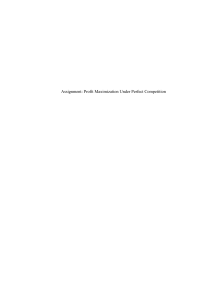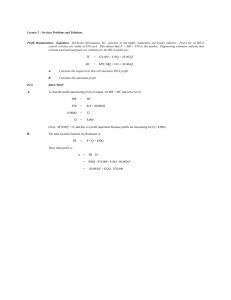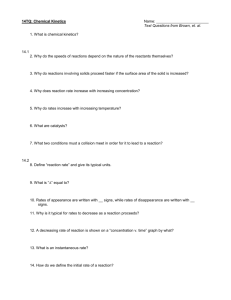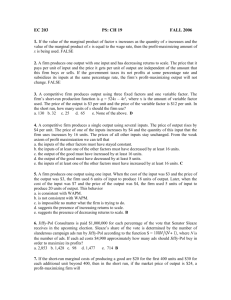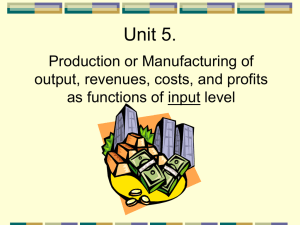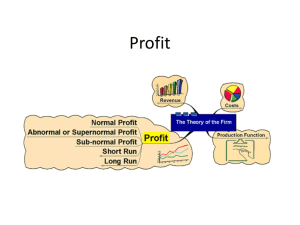lecture2
advertisement
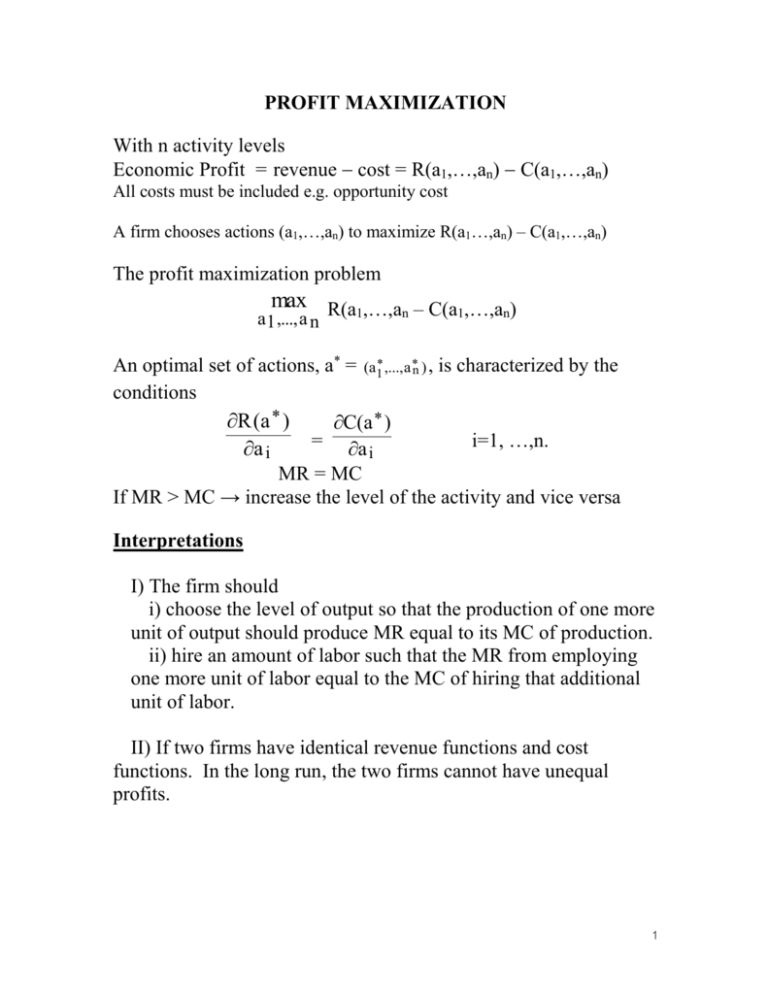
PROFIT MAXIMIZATION
With n activity levels
Economic Profit = revenue cost = R(a1,…,an) C(a1,…,an)
All costs must be included e.g. opportunity cost
A firm chooses actions (a1,…,an) to maximize R(a1…,an) – C(a1,…,an)
The profit maximization problem
max R(a1,…,an – C(a1,…,an)
a1 ,..., a n
An optimal set of actions, a* =
conditions
(a1* ,..., a *n ) ,
is characterized by the
R (a * )
a i
C(a * )
= a
i=1, …,n.
i
MR = MC
If MR > MC → increase the level of the activity and vice versa
Interpretations
I) The firm should
i) choose the level of output so that the production of one more
unit of output should produce MR equal to its MC of production.
ii) hire an amount of labor such that the MR from employing
one more unit of labor equal to the MC of hiring that additional
unit of labor.
II) If two firms have identical revenue functions and cost
functions. In the long run, the two firms cannot have unequal
profits.
1
Alternatively, write
Profit = Revenue – Cost
= price of output times output – price of input times input
The firm can choose to set prices instead of output level but it
cannot set prices and activity levels unilaterally
In general the firm faces two types of constraints:
I) Technological constraints concern the feasibility of the
production plan
II) Market constraints concern the effect of actions of other
agents, e.g. consumers and suppliers of inputs
EXAMPLE
Competitive firm: Firm takes price as given
Situation where price-taking behavior might be appropriate
i) well-imformed consumers
ii) homogeneous product
iii) large number of firms.
Then it is reasonably clear that all firms must charge the same price.
Profit maximization of Competitive Firms
Let p be a vector of prices for inputs and outputs of the firm.
Profit Function (p) gives the maximum profits as a function of
the prices
(p) = max py
such that y is in Y
Short-run Profit Function or Restricted Profit Function:
(p, z) = max py
such that y is in Y (z)
2
The Case with Single Output and Multiple Inputs
(p, w) = max pf(x) – wx
where p is now the (scalar) price of output w is the vector of factor
prices.
Define the Cost Function as
c(w, y) = min wx
such that x is in V (y).
i.e. c(w, y) gives the minimum cost of producing a level of output y
when factor prices are w.
Then Restricted or Short-run Cost Function:
c(w,y, z) = min wx
such that (y, -x) is in Y (z)
First-Order Conditions:
f ( x * )
p x = wi
i
i = 1, …, n.
Value of marginal product of factor i = price of i
Vector notation
PDf(x*) = w.
f ( x* ) f ( x* )
*
where Df(x ) = x ,..., x is the gradient of f(x)
1
n
Second-Order Conditions:
The Hessian matrix D2 f(x*) (The matrix of second derivatives of
the production function) must be negative semidefinite at x*
hD2 f(x*)ht 0 for all vector h.
3
2 f ( x* )
where D f(x ) = x x
i j
2
*
The production function must lie below its tangent hyperplane at x*
Note: D2 f(x*) is negative semidefinite iff the principal minor
determinants of order k have sign (-1)k for k = 1,…n
Two-dimensional case: Π= py – wx.→ y = Π/p + (w/p)x.
OUTPUT
Slope=w/p
=py-wx
y=f(x)
/p
INPUT
Profit maximization: Slope of the isoprofit line equals the slope of
the production function.
df ( x * ) w
Tangency condition (F.O.C) : dx p
d 2 f ( x* )
0 → locally concave at x*
Second-order condition:
dx 2
Definitions
Factor Demand Function x(p,w) gives the optimal choice of
inputs as a function of the prices is of the firm.
Supply function of the firm y(p,w) = f(x(p,w))
4
DIFFICULTIES
i) Technology cannot be described by a differentiable production
The Leontief technology
ii) The above conditions are valid only for interior solutions –
where each of the factors is used in a positive amount.
To handle boundary solutions, the relevant first-order conditions
are
f ( x)
p
wi 0 if xI = 0
xi
f ( x)
p
wi 0 if xI > 0
xi
Note that the marginal profit from increasing xI must be
nonpositive, otherwise the firm would increase xi
iii) There may exist no profit-maximizing production plan.
For example if f(x) = x when p > w, want to choose x → ∞
A maximal profit production plan exists only when p < w, →
profits = zero.
For any constant-returns-to-scale technology.
Pf(x*) wx* = * > 0
Pf(tx*) wtx* = t[pf(x*) wx*] = t* > *
The only nontrivial profit-maximizing position for a constantreturns-to-scale firm is one involving zero profits. It is indifferent
about the level of output at which it produces.
iv) Even when a profit-maximizing production plan exists, it may
not be unique. e.g. the case of CRS technology
5
EXAMPLE: The profit function for Cobb-Douglas technology
Cobb-Douglas technology f(x) = xa where a > 0.
The first-order condition is
paxa-1 = w
Second-order condition reduces to
pa(a-1)xa-2 < 0
The second-order condition can only be satisfied when a < 1, which
means that the production function must have constant or
decreasing returns to scale for competitive profit maximization to
be meaningful.
If a = 1 → F.O.C.: p = w.
When w = p any value of x is a profit-maximizing choice.
If a < 1, use F.O.C. to solve for the factor demand function
w
X(p,w) = ap
1
a 1
The supply function is given by
w
1
a 1
Y(p,w) = f (x(p,w)) = ap
The profit function is given by
1
a1
1 a w
( p, w) py( p, w) wx( p, w) w
a ap
6
Properties of Demand and Supply Functions
The factor demand functions xi (p,w) for i = 1, …, n
must satisfy the restriction that
xi(tp, tw) = xi(p,w)
(see tangency condition)
i.e. homogeneous of degree zero.
COMPARATIVE STATICS using the first-order conditions
Comparative Statics (Sensitivity analysis): The study of how an
economic variable responds to changes in its environment
The term comparative refers to comparing a “before”and an
äfter”situation. The term statics refers to the idea that the
comparison is made after all adjustments have been “worked out”
that is, we must compare one equilibrium situation to another.
Example: one output and one input
max pf ( x) wx
x
If f(x) is differentiable, necessary F.O.C. and S.O.C. are
pf(x(p,w)) – w 0
pf(x(p,w)) ≤ 0
i.e. by definition x(p,w) must satisfy the conditions identically
Differentiate w.r.t w
dx( p, w)
dw –1 0
Assuming regular maximum so that f (x) is not zero,
pf(x(p,w))
dx( p, w)
1
pf ( x( p, w))
dw
If the production function is very curved in a neighborhood of the
optimum, then the change in factor demands as the factor price
changes will be small.
7
From second-order condition,
f (x(p,w)), is negative → dx(p,w)/dw is negative.
The factor demand curve slopes downward.
The Case of Two Inputs
normalize p = 1, F.O.C. are
f ( x1 ) w1 , w2 ), x2( w1 , w2 ))
w1
x1
f ( x1 ) w1 , w2 ), x2(w1 , w2 ))
w2
x2
Differentiating with respect to w1,
x1
x
f 12 2 1
w1
w1
x
x
f 21 1 f 22 2 0
w2
w2
f 11
Differentiating with respect to w2,
x1
x
f 12 2 0
w1
w2
x
x
f 21 1 f 22 2 1
w2
w2
f 11
In matrix form
f11
f 21
x1
f12 w1
f 22 x2
w
1
x1
w2 1 0
x2 0 1
w2
8
Assume that we have a regular maximum, the Hessian matrix
f11
f
21
f12
f 22
is nonsingular, thus
x1
w1
x2
w
1
Substitution Matrix
x1
w2
x2 =
w2
x1
w1
x2
w
1
f11
f
21
x1
w2 describes
x2
w2
f12
f 22
1
how firm substitutes one
input for another as factor prices changes.
Since the inverse of a symmetric negative definite matrix is a
symmetric negative definite matrix. We have
1) xi/wi < 0, for i = 1,2, since the diagonal entries of a negative
definite matrix must be negative.
2) xi/wj = xj/wi by the symmetry of the matrix
The Case of Multiple Inputs
Normalizing p = 1, F.O.C. are
Df(x(w)) – w 0
Differentiate with respect to w,
D2f(x(w)) Dx(w) – I 0
Assume a regular maximum and solve for the substitution matrix,
Dx(w) [D2f(x(w))]-1
is symmetric negative definite
If w changes to w+dw, →dx = Dx(w)dwt and
dwdx = dwDx(w)dwt ≤ 0
by the definition of a negative
The inner product of the (infinitesimal) change in factor prices and
the change in factor demands must always be nonpositive
9
COMPARATIVE STATICS using algebra
Suppose we have a list of observed price vectors pt, and the
associated net output vectors yt, for t = 1, …, T.
The data are (pt, y(pt)) for some observations t = 1,…, T.
Weak Axiom of Profit Maximization (WAPM):
ptyt ptys
for all t and s = 1,…, T.
is implied by a necessary condition for profit maximization is that
A
B
OUTPUT
OUTPUT
. .
y2
y1
.
y1
.
y2
INPUT
INPUT
Panel A shows two observations that violate WAPM,
since p1y2 > p1y1.
Panel B shows two observations that satisfy WAPM.
Consequences:
Adding →
pt(yt – ys) 0 and – ps(yt – ys) 0
(pt – ys)(yt – ys) 0
Letting p = (pt – ps) and y = (yt – ys) → py 0
The inner product of a vector of price changes with the associated
vector of changes in net outputs must be nonnegative
Applies to all changes in prices, not just infinitesimal changes.
10
2.6 Recoverability
Recoverability: The operation of constructing a technology
consistent with the observed choices.
We will show that if a set of data satisfies WAPM it is always
possible to find a technology for which the observed choices are
profit-maximizing choices.
Our task is to construct a production set that will generate the
observed choice (pt, yt) as profit-maximizing choices
Suppose that the true production set Y is convex and monotonic.
The Inner Bound = the smallest convex, monotonic set that
contains y1, …,yt. This set is called the convex, monotonic hull of
the points y1, …,yT and is denoted by
YI = convex, monotonic hull of {yt : t = 1, …, T}
YI must be contained in any convex technology that generated the
observed behavior: It gives us an “inner bound” to the true
technology that generated the observed choices.
The Outer Bound to this “true” technology = A set YO that is
guaranteed to contain any technology that is consistent with the
observed behavior?
Rule out all of the points that could not possibly be in the true
technology
NOTY = {y: pty >ptyt for some t }
Hence,
YO = {y: pty ptyt for all t = 1, …, T}.
YO must contain any production set consistent with the data (yt).
11
